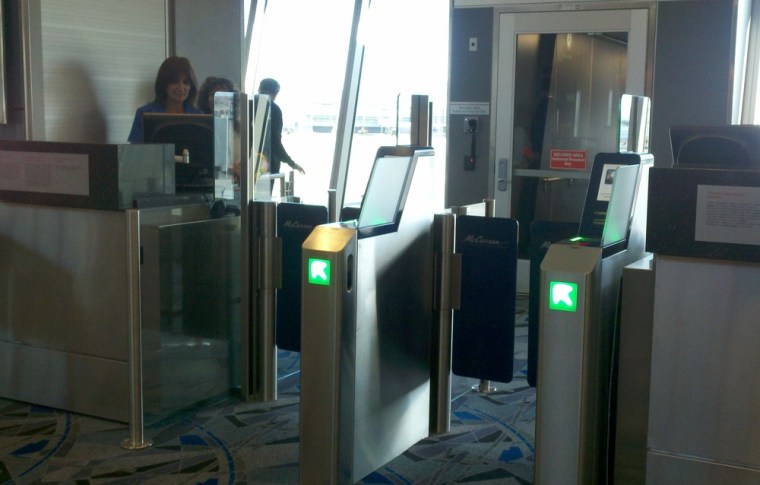Self-service is king when it comes to flying these days, with travelers checking in online, downloading their own boarding passes and tagging their bags.
But passengers outside the U.S. often perform one more task on their own at the airport: self-boarding.
Scan your boarding pass at a gate equipped with a subway-like turnstile, and voilà, you’re on your way to the plane—no gate agent required.
It’s an option travelers seem to love: Almost 90 percent said self-boarding is their favorite self-service technology in a survey of more than 2,500 passengers from 70-plus countries released on Tuesday. The poll was conducted by SITA, a company that specializes in air transport communications.
You’ll likely encounter automated gates at airports in Europe or Asia, but in the United States, they are still a rare sight. One of the few places you’ll see them is at the shiny, new Terminal 3 at McCarran International Airport in Las Vegas, where JetBlue has been testing self-boarding since July.
“We are receiving positive feedback -- customers do like it and it does speed up the boarding process,” said JetBlue spokeswoman Tamara Young. “There’s not the bunching that was previously experienced with the agents taking the tickets.”
Gate agents are still there, watching over the process to make sure travelers don’t encounter any snags, Young said.
Those snags are one of the reasons airlines have been proceeding carefully, industry observers said.
“If you've seen people using self-check-out at supermarkets, they aren't generally as adept at scanning bar codes as the actual check out personnel,” said Robert W. Mann Jr., an airline industry analyst.
“When you narrow it down to the pointy end of the funnel, when everybody is trying to get on the airplane through one door, the person who struggles with the scanning is holding up 150 people and they’re all (upset).”
Still, self-boarding seems to be an attractive option for both airlines and travelers.
Some 17 international carriers now use the technology and there are 113 automated gates at airports around the world, according to recent figures collected by the International Air Transport Association (IATA). The group, which represents some of the world’s biggest airlines, supports self-boarding as part of its "Fast Travel" initiative.
Airlines that pioneered the process include SAS and Lufthansa in Europe, and All Nippon Airways in Asia, said IATA spokesman Perry Flint.
Passengers may like the service because it’s somewhat empowering, Mann said. Travel requires people to give up a lot of control over their environment, so this is a small instance where they can take charge.
But the cost of installing the gates may be an obstacle for carriers in the U.S., where airlines usually own or rent the check-in space in airports where they operate and can’t spread the expense among several different users, Flint said.
“It may not make economic sense for the airline to make that investment if they’re the only ones who are going to be using it and if they are already operating at a very high level of efficiency,” Flint said.
Bottom line: Don’t look for automated self-boarding gates dominating U.S. airports any time soon, but be ready for subway-like boarding in other parts of the world.
And don’t forget your smartphone when you travel.
The SITA survey also found that the number of passengers with the gadgets has “risen dramatically” over the past year, from 54 percent to 70 percent.
“We’re now at the tipping point of explosive growth in mobile services offered to passengers, which will give them more control over their journey and reduce stress,” said Francesco Violante, the CEO of SITA.
